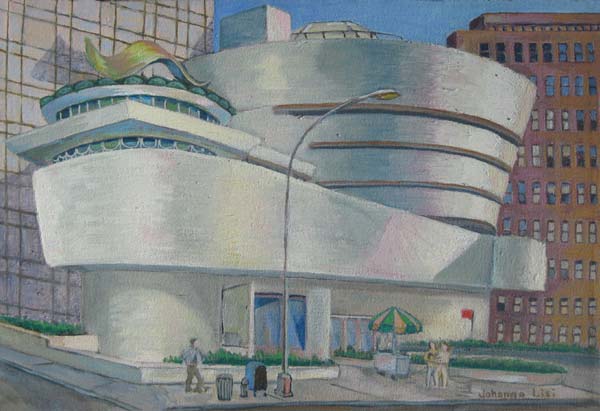The Secret to Making it in the Art World?
The Surprising Formula for Becoming
an Art Star:
... Study maps the galleries, museums that determine the next Picasso,
as well as the ones that don’t have as much sway
By Kelly Crow,
WSJ Nov. 8, 2018
The Guggenheim Museum © Johanna
Lisi
Oil on Canvas, 12" x 16"
An early-career exhibition at museums like New York’s Guggenheim all but guarantees a successful art career, according to newly published research.
The secret to making it in the art world? Learn to schmooze.
A handful of U.S. and European museums and galleries have an outsize impact
on which contemporary artists achieve lasting, prestigious careers and
which don’t, according to a Northeastern University study published
Thursday in the journal Science.
New artists who show their work early in a relatively small network of
400 venues—like Gagosian Gallery or the Guggenheim Museum—are
all but guaranteed a successful art career, the study said. By contrast,
artists who exhibit mainly in lower-level galleries and midtier institutions
are likely to remain stuck in that orbit.
“There’s this invisible network of trust that exists in the
art world, but the group that decides who matters in art was considerably
smaller and more powerful than we expected,” said Albert-László
Barabási, a data scientist who studies networks at Northeastern
and led the study along with several colleagues including a data scientist
now at the World Bank, Samuel Fraiberger. Their findings also show up
in Dr. Barabási’s book published earlier this week, “The
Formula: The Universal Laws of Success.”
His findings undermine a popular art-world notion that a prodigy could
create in obscurity and get discovered years later. Instead, the research
suggests that artists who start out seeking connections with powerful
curators, dealers and collectors within the nerve center of the art world
are far more likely to hit the big time.
Dr. Barabási and his team spent the past three years reconstructing
the exhibition histories of nearly 500,000 artists, whose work was shown
in about 16,000 galleries and 7,500 museums between 1980 and 2016. He
and his team also scoured sales held in 1,239 global auction houses from
the same 36-year time period.
They used this data to help trace the paths that artists took early in
their careers, tracking how one who earned a spot on the roster of Gallery
A subsequently got exhibited in Museum B and then Museum C, for example.
Dr. Barabási analyzed the overlapping connections and mapped the
institutions that proved key in helping the most artists succeed in the
long run—or not.
The result is a formula Dr. Barabási said can predict which artists
working now, based on their connections within this network, are more
likely to become superstars.
“If one of your first five shows as an artist is held at a gallery
in the heart of this network, the chances of your ending your career on
the fringes is 0.2%,” Dr. Barabási said. “The network
itself will protect you because people talk to each other and trade each
other’s shows.”So who makes up the nucleus of this network?
The list skews toward U.S. institutions like the Museum of Modern Art,
the Art Institute of Chicago, the J. Paul Getty Museum and the Metropolitan
Museum of Art. European museums include the Haus der Kunst in Munich and
Tate in London. Dealers include Paula Cooper as well as galleries with
multiple locations and sizable operations like Pace Gallery, Hauser &
Wirth and David Zwirner.
Magnus Resch, an economist who teaches at Columbia University and who
helped Dr. Barabási gather the data, said he was devastated by
the findings because they suggest that myriad galleries outside this hub
have little impact, no matter the quality of the art they show or sell.
“The art world prides itself on being so open and inclusive, but
the truth is the opposite,” Mr. Resch said.
The study also maps out so-called islands on the network’s periphery,
populated by galleries and museums in places like Germany, Australia and
parts of Asia that appear insular to a fault. For example, Germany is
replete with noncollecting museums called kunsthalles that organize many
shows featuring young artists, but Dr. Barabási said his research
revealed that few of these venues wound up swapping artists with the influential
museums that ultimately determine an artist’s success.
“The conduit to bigger success isn’t there,” he said,
though he conceded there were likely exceptions.
The network also benefits artists who live in cities with thriving art
markets like New York and London. Of the artists tracked in the study
who were born in the U.S., a quarter earned spots in highly prestigious
venues, compared with 11% of artists in Canada and 9.2% of artists in
India.
The network isn’t defined solely by geography, though. Galleries
physically located near MoMA weren’t necessarily more influential
than ones in San Francisco or Shanghai, the study found. In some respects,
Dr. Barabási said it mattered more for an artist to get a show
at a major, encyclopedic museum like the Art Institute of Chicago than
a buzzy, contemporary art museum.
That’s because the Art Institute shows fewer living artists, and
so it “has more heft,” he said. So far this year, the Chicago
museum has opened shows featuring a dozen living artists. Last year, it
showed eight.
James Rondeau, director of the Art Institute, said he remains skeptical
of success metrics in the art world, but added that he wonders if the
research could nudge curators out of ruts they might be in when it comes
to scouring for talent.
“Maybe we can use it to give voice to those disenfranchised artists
outside the trajectory,” Mr. Rondeau said. “We need to use
our eyes as much as our ears.”
Write to Kelly Crow at kelly.crow@wsj.com
Reprinted from The Wall Street Journal, November 12, 2018
